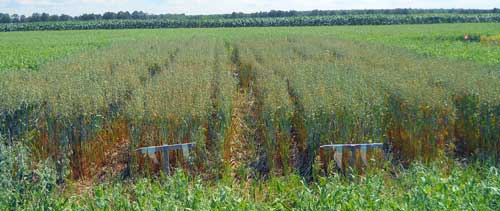Fungicide trial on oats shows favorable results
Second-year oat fungicide, on-farm trials in Michigan’s Upper Peninsula shows advantage based on single application.
A follow-up trial funded by Project GREEEN was conducted in the Upper Peninsula to determine if fungicide application to oats makes economic sense. This trial included small, replicated plots on the MSU Upper Peninsula Research Center in Chatham, Mich., and larger strip trials on a farm in Trenary, Mich. Two of the three fungicides included in the trial show that a single application at early-mid flowering resulted in improved yields large enough to exceed the cost of application. All yields were corrected to 13.5 percent moisture.

Oat fungicide trial at MSU U.P.
Research Center in Chatham, Mich.
Taken July 18, 2012.
The small plots at Chatham, Mich., were treated at mid-flowering with either Twinline (pyraclostrobin + metconazole) or Caramba (metconazole), or not sprayed with fungicide (control). The Twinline-sprayed plots averaged 114 bushels/acre, Caramba-sprayed plots averaged 108 bushels per acre, and untreated plots averaged 100 bushels per acre. At 10 percent level of significance – meaning you can be 90 percent sure the yield difference is due to treatments, not field variability – the Twinline fungicide plots yielded significantly better than the control, statistically. Caramba-treated plots did not. At 20 percent level of significance – 80 percent sure about yield differences – both fungicide treatments produced better yield than the control, statistically. Grain test weight was statistically better at 5 percent level of significance from Twinline-treated plots (average 34.6 lb/bu) than from control (avg. 33.8 lb/bu) or Caramba-treated plots (avg. 33.6 lbs/bu). These plots were planted with non-treated Excel oats at 96 lbs. per acre on May 9, fungicides sprayed on June 27, and harvested on August 14, 2012.
The strip trial plots on the Mike Iho farm in Trenary, Mich., were larger (25 X 254 feet) and replicated three times. Stratego fungicide (trifloxystrobin + propiconazole) was applied at mid-flowering. One fungicide-treated plot was ruined by wildlife. Yield data from this ruined plot was replaced by the average of the other two treated plots, making the statistical results less dependable. The fungicide-treated plots averaged 78 bushels per acre. The control plots averaged 69 bushels per acre. At 10 percent level of significance, this is a statistically meaningful difference in yield. There was also a significant difference in test weight between Stratego-treated plots (35.0 lbs/bu) and control plots (34.2 lbs/bu) at 5 percent level of significance. These plots were planted with non-treated oats (variety not specified) at 100 lbs. per acre and hay seeding on April 23, sprayed with fungicide on June 23, and harvested on August 8, 2012.
Visual disease ratings were taken on all plots July 6, 17, 20 and 31. Disease pressure was not high. The only disease noted was Septoria leaf blotch, covering as much as 5 percent of the flag leaf surface. Crown rust was not apparent anywhere in the plots.
What about the economics? Is it worthwhile to spray fungicide on oats?
First, a few assumptions must be made:
- Estimated price received by farmer for 2012 oats – $3.25
- Estimated per-acre cost of fungicide application – $10.97 Stratego fungicide/acre (7 oz/acre at $200.60/gallon)
- Estimated per-acre cost of fungicide application – $19.91 Caramba fungicide/acre (14 oz/acre at $182.00/gallon)
- Estimated per-acre cost of fungicide application – $18.19 Twinline fungicide/acre (9 oz/acre at $258.65/gallon)
- Estimated per-acre cost of fungicide application – $6.50 Machinery and labor
|
Avg. yield (bu/a) |
Value of yield above control |
Cost of fungicide treatment |
Income per acre above control | |
|
Non-treated oats (control) |
100 |
0 |
$0 |
$0 |
|
Caramba-treated oats |
108 |
$26.00 |
$26.41 |
- $0.41 |
|
Twinline-treated oats |
114 |
$45.50 |
$25.41 |
+ $20.09 |
|
Avg. yield (bu/a) |
Value of yield above control |
Cost of fungicide treatment |
Income per acre above control | |
|
Non-treated oats (control) |
69 |
0 |
0 |
$0 |
|
Stratego-treated oats |
78 |
$29.25 |
$17.47 |
+ $11.78 |
Short answer: We did see an economic advantage when applying Twinline and Stratego fungicides to oats at one location each. It was not economically beneficial to apply Caramba at the single location tested.
Disease resistance is also a key component in managing disease in oats. This project included only one known variety, and one field of “variety not specified” oats. Although these seed types are common, they do not provide varietal comparisons.
For oat variety information:
- Ontario Spring cereals performance Trials 2012
- Wisconsin Oats and Barley performance tests 2012
- Oat Variety Trial Results, Minnesota Ag Experiment Station 2012
For more information on the 2012 MSU Extension oat fungicide trial, contact Jim Isleib, U.P. crop production educator, at 906-387-2530.



 Print
Print Email
Email



